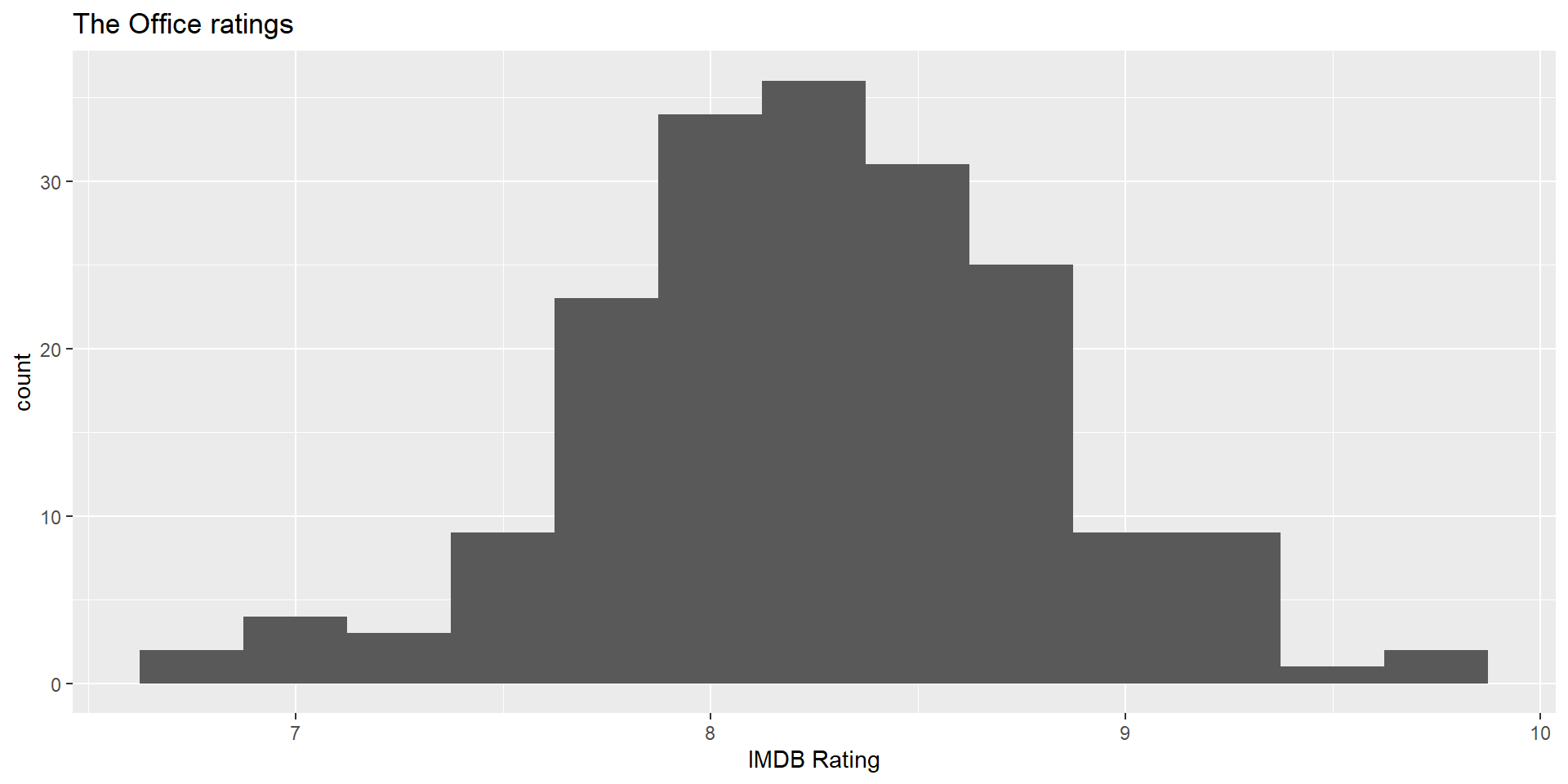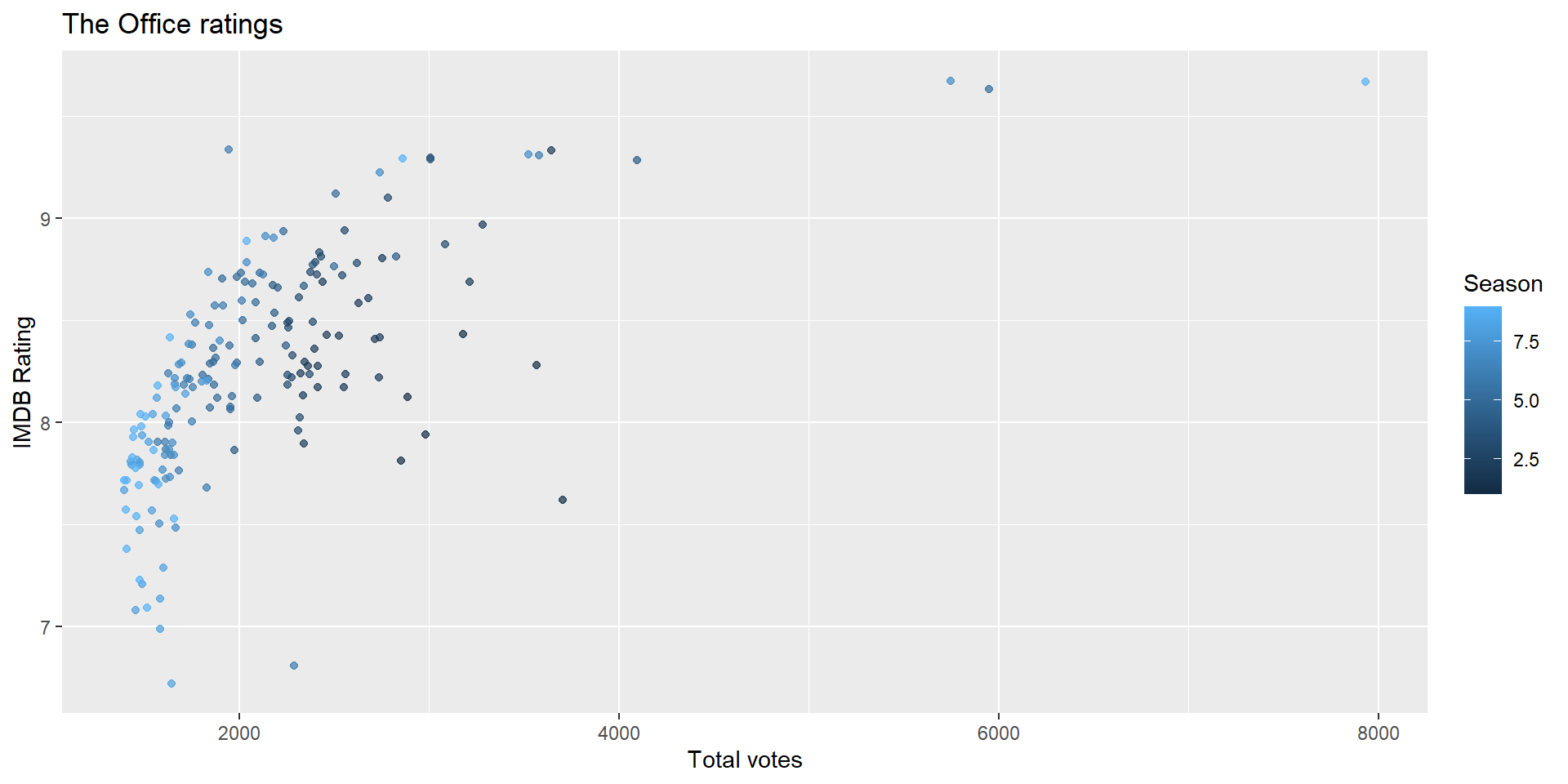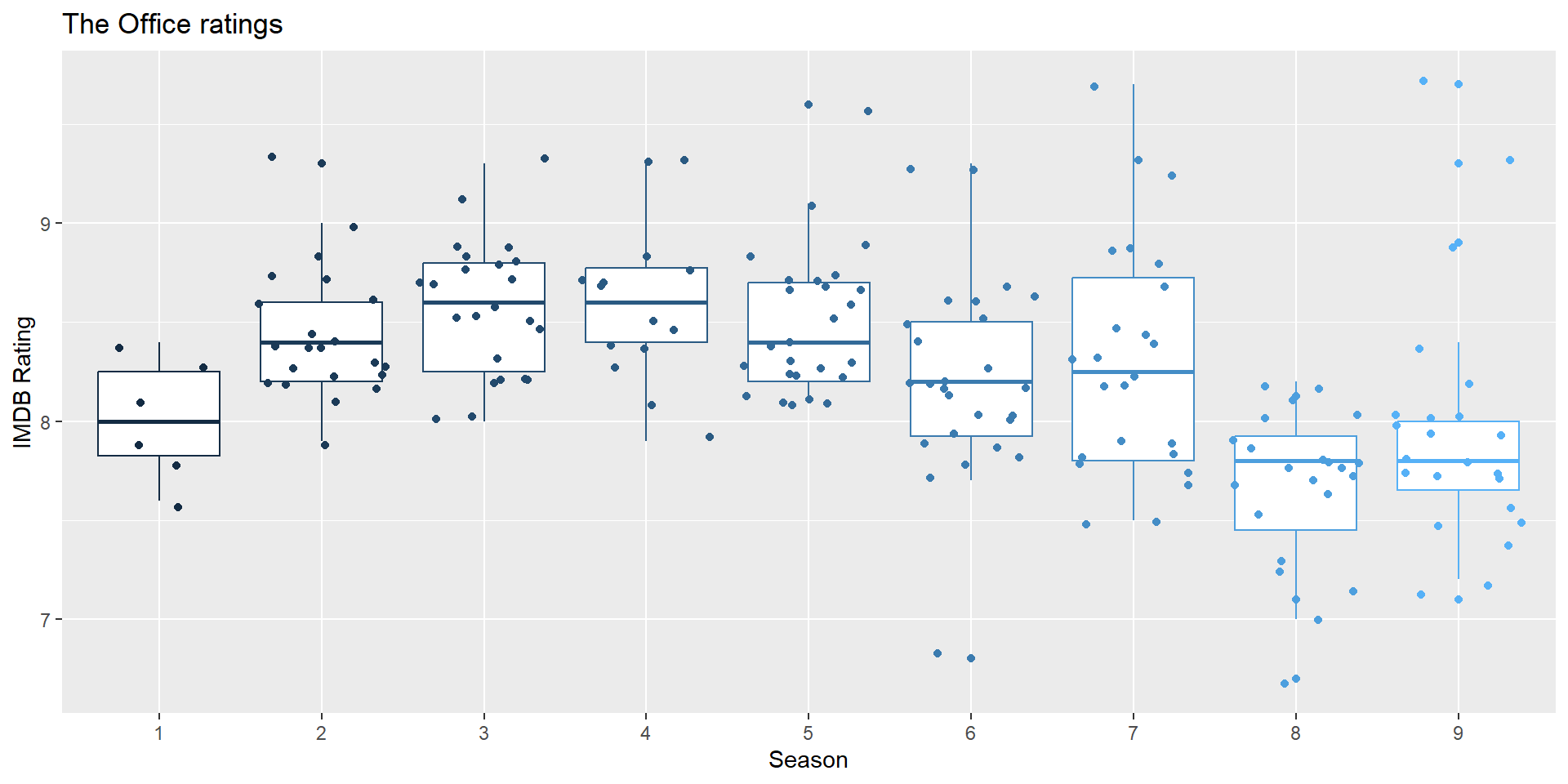Overfitting and Data Splitting
Cornell College
DSC 223 - Spring 2024 Block 7
Goals
- Overfitting
- Data splitting to avoid overfitting
Setup
Data and exploration

Data
# A tibble: 188 × 6
season episode title imdb_rating total_votes air_date
<dbl> <dbl> <chr> <dbl> <dbl> <date>
1 1 1 Pilot 7.6 3706 2005-03-24
2 1 2 Diversity Day 8.3 3566 2005-03-29
3 1 3 Health Care 7.9 2983 2005-04-05
4 1 4 The Alliance 8.1 2886 2005-04-12
5 1 5 Basketball 8.4 3179 2005-04-19
6 1 6 Hot Girl 7.8 2852 2005-04-26
7 2 1 The Dundies 8.7 3213 2005-09-20
8 2 2 Sexual Harassment 8.2 2736 2005-09-27
9 2 3 Office Olympics 8.4 2742 2005-10-04
10 2 4 The Fire 8.4 2713 2005-10-11
# ℹ 178 more rowsSource: The data come from data.world, by way of TidyTuesday.
IMDB ratings
IMDB ratings vs. number of votes
Outliers
If you like the Dinner Party episode, I highly recommend this “oral history” of the episode published on Rolling Stone magazine.
IMDB ratings vs. seasons
Modeling
Train / test
- Create an initial split
- Save training data
- Save testing data
Specify model
Build recipe
office_rec <- recipe(imdb_rating ~ ., data = office_train) |>
# title isn't a predictor, but keep around to ID
update_role(title, new_role = "ID") |>
# extract month of air_date
step_date(air_date, features = "month") |>
step_rm(air_date) |>
# make dummy variables of month
step_dummy(contains("month")) |>
#remove zero variance predictors
step_zv(all_predictors())── Recipe ────────────────────────────────────────────────────────────────────────────────── Inputs Number of variables by roleoutcome: 1
predictor: 4
ID: 1── Operations • Date features from: air_date• Variables removed: air_date• Dummy variables from: contains("month")• Zero variance filter on: all_predictors()Build workflow
══ Workflow ══════════════════════════════════════════════════════════════════════════════
Preprocessor: Recipe
Model: linear_reg()
── Preprocessor ──────────────────────────────────────────────────────────────────────────
4 Recipe Steps
• step_date()
• step_rm()
• step_dummy()
• step_zv()
── Model ─────────────────────────────────────────────────────────────────────────────────
Linear Regression Model Specification (regression)
Computational engine: lm Fit model
# A tibble: 12 × 5
term estimate std.error statistic p.value
<chr> <dbl> <dbl> <dbl> <dbl>
1 (Intercept) 7.23 0.205 35.4 3.14e-68
2 season -0.0499 0.0157 -3.18 1.86e- 3
3 episode 0.0353 0.0101 3.50 6.44e- 4
4 total_votes 0.000352 0.0000448 7.85 1.39e-12
5 air_date_month_Feb 0.0242 0.147 0.165 8.69e- 1
6 air_date_month_Mar -0.145 0.144 -1.01 3.16e- 1
7 air_date_month_Apr -0.106 0.140 -0.759 4.49e- 1
8 air_date_month_May 0.0575 0.175 0.329 7.43e- 1
# ℹ 4 more rowsEvaluate model
Make predictions for training data
office_train_pred <- predict(office_fit, office_train) |>
bind_cols(office_train |> select(imdb_rating, title))
office_train_pred# A tibble: 141 × 3
.pred imdb_rating title
<dbl> <dbl> <chr>
1 7.90 8.1 Garden Party
2 8.43 7.9 The Chump
3 7.81 7.1 Here Comes Treble
4 7.94 6.7 Get the Girl
5 7.92 7.9 Tallahassee
6 8.29 7.7 The Inner Circle
7 7.95 7.8 The Sting
8 8.00 7.8 WUPHF.com
9 9.56 9.6 Stress Relief
10 8.11 8.1 Manager and Salesman
# ℹ 131 more rowsR-squared
Percentage of variability in the IMDB ratings explained by the model
# A tibble: 1 × 3
.metric .estimator .estimate
<chr> <chr> <dbl>
1 rsq standard 0.500Question: Are models with high or low \(R^2\) more preferable?
RMSE
An alternative model performance statistic: root mean square error
\[ RMSE = \sqrt{\frac{\sum_{i = 1}^n (y_i - \hat{y}_i)^2}{n}} \]
# A tibble: 1 × 3
.metric .estimator .estimate
<chr> <chr> <dbl>
1 rmse standard 0.373Question: Are models with high or low RMSE are more preferable?
Interpreting RMSE
Question: Is this RMSE considered low or high? ]
# A tibble: 1 × 2
min max
<dbl> <dbl>
1 6.7 9.7but, really, who cares about predictions on training data?
Make predictions for testing data
office_test_pred <- predict(office_fit, office_test) |>
bind_cols(office_test |> select(imdb_rating, title))
office_test_pred# A tibble: 47 × 3
.pred imdb_rating title
<dbl> <dbl> <chr>
1 8.52 8.4 Office Olympics
2 8.54 8.6 The Client
3 8.90 8.8 Christmas Party
4 8.71 9 The Injury
5 8.50 8.2 Boys and Girls
6 8.46 8.4 Dwight's Speech
7 8.64 8.9 Gay Witch Hunt
8 8.35 8 Diwali
9 8.77 8.7 A Benihana Christmas
10 8.40 8.2 Ben Franklin
# ℹ 37 more rowsEvaluate performance on testing data
- RMSE of model fit to testing data
# A tibble: 1 × 3
.metric .estimator .estimate
<chr> <chr> <dbl>
1 rmse standard 0.386- \(R^2\) of model fit to testing data
Training vs. testing
| metric | train | test | comparison |
|---|---|---|---|
| RMSE | 0.373 | 0.386 | RMSE lower for training |
| R-squared | 0.500 | 0.556 | R-squared higher for training |
Evaluating performance on training data
The training set does not have the capacity to be a good arbiter of performance.
It is not an independent piece of information; predicting the training set can only reflect what the model already knows.
Suppose you give a class a test, then give them the answers, then provide the same test. The student scores on the second test do not accurately reflect what they know about the subject; these scores would probably be higher than their results on the first test.
Source: tidymodels.org




